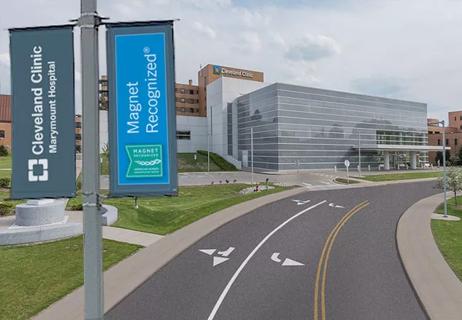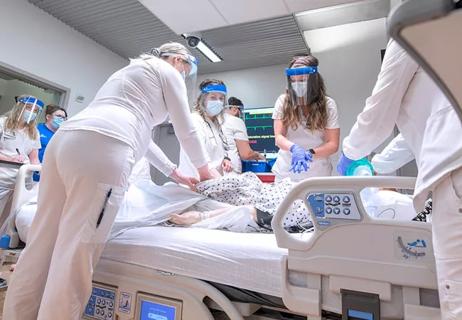Advertisement
HAPU prevention efforts top priority list

Cleveland Clinic’s Wound Care Affinity Group Is ensuring that nursing teams throughout Cleveland Clinic have the tools and resources they need to provide consistently high-quality, evidence-based skin and wound care. The group, which includes co-chairs from main campus and representatives from each community hospital or center, was born from Cleveland Clinic’s Nursing Affinity Group Model. Nurses focus on delivering standardized care in all health system locations in various specialty areas.
Advertisement
Cleveland Clinic is a non-profit academic medical center. Advertising on our site helps support our mission. We do not endorse non-Cleveland Clinic products or services. Policy
“The Wound Care Affinity Group developed unified skin care protocols based on evidence-based research,” says Mary Montague, MSN, APRN, ACNS-BC, CWOCN, co-chair of the Wound Care Consult Team, Nursing Quality Assurance. “We created standards of practice and meet regularly to revise protocols and policies as needed.”
Group members also:
Advertisement
“Wound care nurses provide value to patient care and to the organization through the reduction of HAPUs in all settings,” says Mary Ann Sammon, BSN, WOCN, CWCN, also a co-chair of the Wound Care Consult Team. “This is accomplished by ensuring that wound and skin care protocols reflect contemporary nursing evidence-based practice, that frontline staff has the tools they need to provide basic and preventive care, and that specialty-trained nurses are available for complex wound management.”
A proactive approach is increasingly important to hospitals and health systems across the country, given the Agency for Healthcare Research & Quality guidelines that make stage III, stage IV, unstageable and deep tissue injury (DTI) reportable patient safety indicators. “HAPU quality metrics are now tied to reimbursement, with the Centers for Medicare & Medicaid Services no longer reimbursing institutions for hospital-acquired stage III and stage IV pressure ulcers,” Montague says. “These publically reported metrics also affect how patients view us and how we’re ranked nationally compared to other institutions.”
Increasingly, HAPU interventions hinge on a multispecialty approach to care. In critical care and cardiac care units, nursing administrators, wound care nurses, vascular surgery and plastic surgery are rounding together two times per week to evaluate any patients with a suspected stage III or greater PU, including DTIs as recently defined by the National PU Advisory Panel.
“Our goal is to reach a consensus regarding staging preventive measures and treatments,” says Shannon Pengel, MSN, NE-BC, RN, Clinical Nursing Director for the Heart & Vascular Institute and Critical Care Nursing.
“We want to ensure that we are staging appropriately from the beginning, since HAPUs — especially DTIs — can sometimes be a very subjective assessment,” Pengel says. “The combined perspectives from this multidisciplinary approach create balance and objectivity.” For example, sometimes a maroon or purple area that initially looks like a DTI will have a vascular cause.
Advertisement
On the main campus, the skin assessment team often follows patients for up to two weeks to see how the suspected wound progresses or how it resolves. “What we are seeing is that areas of initial concern often don’t evolve into anything,” Pengel says. Preventing and effectively treating HAPUs hinges on consistency and coordination of care across the health system. “Constant assessment of the skin from the time of admission to the time of discharge — including any time in the operating room — is critical,” Pengel says.
Although data collection will be ongoing for another year or two, data from early quality reports are showing that patient safety indicators (PSIs), reported in six-week periods, appeared to improve by as much as 50 percent. “We hope what we’re learning on main campus could eventually become a standard of practice throughout the system,” Pengel says.
Ongoing initiatives that have the potential for broad application throughout the health system and to other hospitals include:
Another way in which Cleveland Clinic is standardizing care is through the development of a PU prevention and treatment care path. Cleveland Clinic is developing condition-specific care paths for each of the health system’s clinical institutes, including Nursing. The initiative emphasizes value-oriented care by using process-based tools that operationalize evidence-based practice guidelines and guide clinical work flow. The PU care path will be integrated into the electronic medical record system.
Cleveland Clinic’s emphasis on consistent, high-quality care can be easily summed up: “Anytime you can prevent a HAPU, it’s good for the patient and good for the health system,” Sammon says.
Advertisement
Advertisement

Nurses are well-positioned to appraise and integrate evidence into clinical practice to provide quality patient care

Leadership rounds educate nurses and foster teamwork

Veteran nurse shares his experience as a caregiver and community volunteer

Decision tree amplifies commitment

Hospital earns nine exemplars from the Magnet Recognition Program®

Supporting newly graduated RNs before and after the pandemic

PULSES sets forth six critical steps

Creating a roadmap to get everyone on board